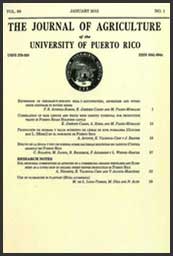Abstract
The effects of sex (female or intact male) and animal type (beef, BT; or dairy, DT) on meat quality attributes of the Longissimus lumborum muscle were evaluated in 89 commercially sourced bovines in Puerto Rico, all having eight permanent incisors (>53 months of age). Mean meat pH was greater (P<0.0001) for BT than for DT (5.75 vs. 5.40), with males of BT and DT having the highest and lowest values, respectively (5.99 vs. 5.32), resulting in a sex x type interaction (P=0.0003). Regarding color parameters, female BT and male DT had lower L* values (darker meat), constituting another sex x type interaction (P<0.0001). Males showed greater a* and b* values than females (more red and yellow colored meat; P<0.05). Females surpassed males (P<0.0001) in intramuscular fat content (9.13 vs. 3.06%) and DT showed a non-significant advantage over BT (8.90 vs. 5.87%). Higher pH was associated with greater water retention (P<0.0001). Warner-Bratzler Shear (WBS) and tenderness scores assigned by untrained sensory panelists indicated non-significant tendencies in favor of females (WBS: 6.13 vs. 7.20 kg), and in favor of BT over DT within males (WBS: 6.69 vs. 7.71 kg). The sensory panel assigned higher juiciness scores to beef from males than females (4.85 vs. 4.16 on a scale from 1 to 8; P=0.0074).

